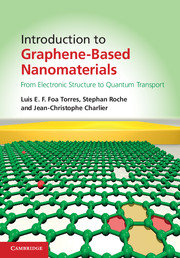Book contents
- Frontmatter
- Contents
- Preface
- 1 Introduction to carbon-based nanostructures
- 2 Electronic properties of carbon-based nanostructures
- 3 Quantum transport: general concepts
- 4 Klein tunneling and ballistic transport in graphene and related materials
- 5 Quantum transport in disordered graphene-based materials
- 6 Quantum transport beyond DC
- 7 Ab initio and multiscale quantum transport in graphene-based materials
- 8 Applications
- Appendix A Electronic structure calculations: the density functional theory (DFT)
- Appendix B Electronic structure calculations: the many-body perturbation theory (MBPT)
- Appendix C Green's functions and ab initio quantum transport in the Landauer–Büttiker formalism
- Appendix D Recursion methods for computing the DOS and wavepacket dynamics
- References
- Index
6 - Quantum transport beyond DC
Published online by Cambridge University Press: 05 February 2014
- Frontmatter
- Contents
- Preface
- 1 Introduction to carbon-based nanostructures
- 2 Electronic properties of carbon-based nanostructures
- 3 Quantum transport: general concepts
- 4 Klein tunneling and ballistic transport in graphene and related materials
- 5 Quantum transport in disordered graphene-based materials
- 6 Quantum transport beyond DC
- 7 Ab initio and multiscale quantum transport in graphene-based materials
- 8 Applications
- Appendix A Electronic structure calculations: the density functional theory (DFT)
- Appendix B Electronic structure calculations: the many-body perturbation theory (MBPT)
- Appendix C Green's functions and ab initio quantum transport in the Landauer–Büttiker formalism
- Appendix D Recursion methods for computing the DOS and wavepacket dynamics
- References
- Index
Summary
In this chapter we give a flavor of quantum transport beyond DC conditions, when time-dependent potentials are applied to a device. Our main focus is on Floquet theory, one of the most useful approaches for driven systems. Section 6.4 is devoted to an overview of some of the most recent advances on driven transport in graphene-related materials, while Section 6.5 presents an illustrative application to laser-illuminated graphene.
Introduction: why AC fields?
Though less explored, quantum transport beyond the DC conditions considered in previous sections also offers fascinating opportunities. Alternating current (AC) fields such as alternating gate voltages, alternating bias voltages or illumination with a laser can be used to achieve control of the electrical response (current and noise), thereby providing a novel road for applications. Furthermore, there are many novel phenomena unique to the presence of AC fields such as quantum charge pumping (Thouless, 1983, Altshuler & Glazman, 1999, Büttiker & Moskalets, 2006, Switkes et al., 1999), i.e. the generation of a DC current even in the absence of a bias voltage due to quantum inter-ference, coherent destruction of tunneling (Grossmann et al., 1991) or laser-induced topological insulators (Lindner, Refael & Galitski, 2011, Kitagawa et al., 2011).
The activity in this area has grown rapidly in the arena of nanoscale systems (Platero & Aguado, 2004, Kohler, Lehmann & Hänggi, 2005). Notwithstanding, it was not until the last few years that advances in the applications to graphene-related systems started to lourish (see the overview in Section 6.4).
- Type
- Chapter
- Information
- Introduction to Graphene-Based NanomaterialsFrom Electronic Structure to Quantum Transport, pp. 219 - 231Publisher: Cambridge University PressPrint publication year: 2014



